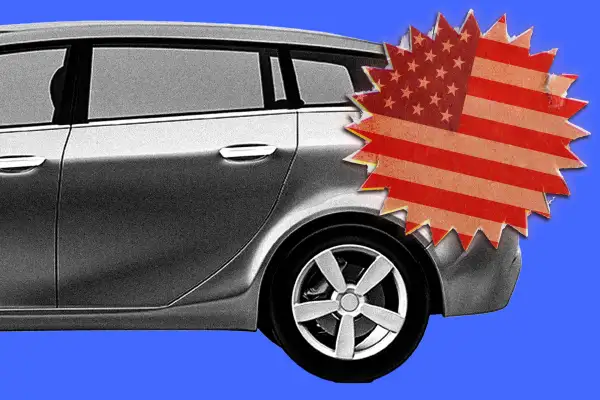Want to Avoid Auto Tariffs? Here's How to Find Out if a Car Is Made in America

As tariffs begin to reshape the auto industry, there's suddenly a new question that's top of mind for car buyers: Was this vehicle made in America?
With some car prices set to rise by as much as $10,000 if tariffs remain in place, car shoppers want to know what's under the hood — or more specifically, where everything's from.
Tariffs likely won't cause car prices to spike immediately, given that new vehicle inventory is currently higher than normal for the auto market overall. Cars.com said in a recent report that at this point it's unclear "if automakers will absorb [the extra cost], pass it on to the consumer on a particular model, or pass it on to the consumer by distributing the price increase across its vehicle lineup."
With President Donald Trump suggesting that tariffs could be permanent in order to bring auto manufacturing jobs back to the U.S., the car industry is now bracing for significant impacts. People buying cars this spring who want to avoid the tariff charges will likely have the most luck shopping for American-made cars or foreign vehicles that were imported before the auto tariffs took effect, experts say.
Determining a vehicle's origin can be extremely complicated, and even American car brands that are trying to emphasize their patriotism in new commercials and marketing may be highly dependent on foreign manufacturing or parts.
"A car can be assembled in one country with parts from dozens of others, and with a badge on the car's hood from an automaker that could be an ocean away from where it goes on sale," says Patrick Masterson, lead researcher for Cars.com's American-Made Index.
It's much simpler, however, to look up where a vehicle was assembled — and that may be all you need to know to avoid the extra cost due to tariffs.
How to tell if a car is affected by tariffs
On April 3, the Trump administration imposed a 25% tariff on the non-U.S. content of vehicles that are assembled abroad. Vehicles manufactured by American automakers at plants in other countries are affected, as are foreign brands like Honda and Volkswagen that build cars outside the U.S. for the American market. That's millions of cars: Last year, about half of all vehicles sold in the the U.S. were assembled in other areas of the world, whether that's Mexico or Canada or a country in Europe or Asia.
For now, vehicles made in the U.S. with parts imported from elsewhere are in the clear.
The National Highway Traffic Safety Administration, or NHTSA, maintains a spreadsheet that lists every vehicle model and the location of final assembly. It also shows where the car's transmission and engine come from. The U.S. content of these vehicles, if any, is exempt from tariffs, so it's potentially a good thing for shoppers if a car's engine is American even if the assembly is in Mexico, for example.
Tariffs on car parts are scheduled for May
If a car is assembled in America using foreign parts, tariffs could soon be a factor in the vehicle's price.
Most car parts from Mexico and Canada will not be immediately subject to the new 25% auto tariffs. Officials say they need time to firm up processes for tariff calculations on car parts that are compliant with the United States-Mexico-Canada Agreement.
For all other countries, 25% tariffs on car parts (including engines, transmissions, powertrain components and electrical parts) are coming on May 3, according to the White House.
These tariffs would increase costs for automakers building cars in the U.S. with foreign components, which means there aren't many cars on the market that would be spared from extra tariff costs.
But the degree of impact could vary widely from one car to another. The NHTSA database will tell you what the percent of a car's content (by value) is from the U.S. and Canada for most vehicles. At dealerships, you can typically also find this info on the window sticker as required by the American Automobile Labeling Act.
How to really tell if a car is American
If you want to dig deeper into how American a car really is, there are resources from academic and industry sources that can help.
Consider using Cars.com's American-Made Index, which covers five categories (assembly location, percentage of U.S. and Canadian parts, engine origin, transmission origin and U.S. manufacturing employees) and ranks the top 100 vehicles out of 400 that were analyzed.
Another tool you can use is the similarly named "Made in America Auto Index" developed by Frank DuBois, associate professor at the American University Kogod School of Business. This index takes into account factors like where the automaker's headquarters are located and where the research and development of a vehicle was completed.
There are some notable absences in the NHTSA data. For example, the Toyota Camry isn't listed in the latest spreadsheet.
The Kogod School researchers filled in some of these gaps in the NHTSA data by visiting dealerships and looking at cars' window stickers. DuBois also recommends using VIN numbers to check where a vehicle is assembled, as this method is even more reliable than the window stickers, according to his research.
The first digit of the VIN will tell you where the car was assembled. U.S. numbers start with 1, 4 or 5. Other common country codes are Mexico (3), Canada (2), Japan (J) and Korea (K).
More from Money:
Your Next Car Could Cost 10% More Thanks to Trump's Tariffs
After 4 Straight Months of Price Increases, a New Car Now Costs Nearly $50,000
